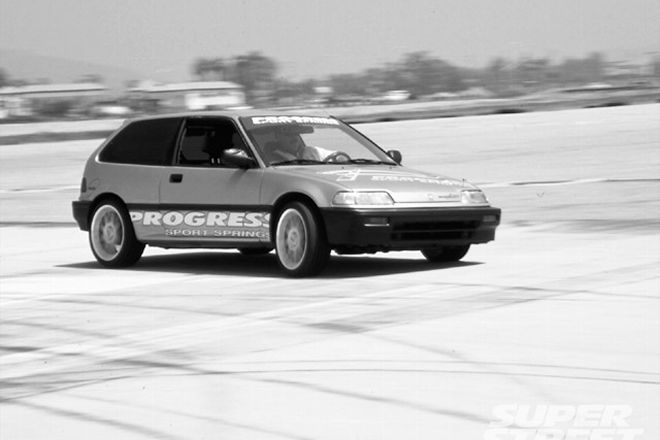Turn the steering wheel at 40 mph and the little Civic turns; add steering lock, and it turns more. Neck-snapping cornering power is what handling is all about, and the Progress Grove Honda Civic leaves your neck muscles screaming for relief. Exceeding 1.0 G cornering force is not that unusual-for race cars. But for a daily-driven '89 Civic with aftermarket springs, antiroll bars, shocks and bushings, and no fender flares for fatter tires-well, that's really an accomplishment.
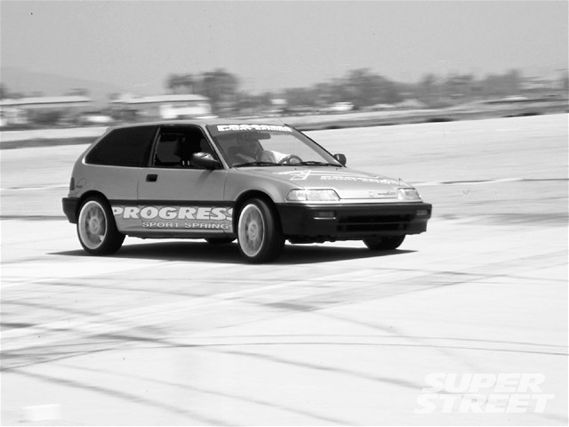 |
Improving 1989 Honda Civic Handling - Civic Class
|
Improving 1989 Honda Civic Handling - Civic Class
Let's gain a little perspective. A Formula 1 car corners in high-speed turns at 3.5 Gs, an Indy Car at 2.5 Gs, and a British Touring Car at about 1.5 Gs. The F1 and Indy cars have enough downforce at 190 mph to triple the load on the tires. That accounts for most of the traction. They all have state-of-the-art chassis structures, sophisticated suspension systems, and none of them would last 30 seconds on the streets we drive every day. So, any car that can be comfortably driven on the streets and highways of your neighborhood and exceed 1.0 G cornering force is quite a machine.
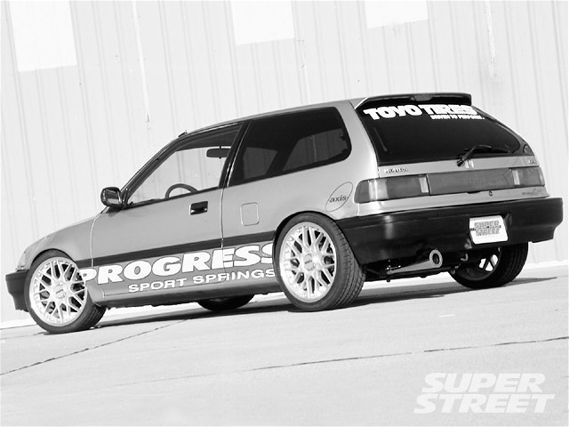 |
Improving 1989 Honda Civic Handling - Civic Class
|
Improving 1989 Honda Civic Handling - Civic Class
Thirty years ago, the SCCA Trans-Am Camaro campaigned by Roger Penske and driven by the legendary Mark Donahue could barely reach 0.90 Gs on the skidpad. Even in 1999, stock cars like the Corvette, BMW M3, or the Toyota Supra Turbo are not able to pull 1.0G lateral acceleration on the skidpad.
So what does it take to turn a mild-mannered Civic into a mean and nasty corner-basher? It's simple: traction! Actually, it's not that simple. Traction is the key, but many elements come into play when attempting to get maximum traction. The obvious place to start is with tires. Progress used the Toyo Proxes RA-1 (205/50ZR15) and the Toyo Proxes T1 Plus (205/40ZR17) for this project. When it comes to tires, traction is increased when the tire rubber compound is softer and when the tire contact patch is bigger. The tread design and sidewall construction also play a role in allowing the tire contact patch to work on the road surface and maintain contact with the surface. Even the softest tire will not achieve good results if the tread design and sidewall construction miss the mark.
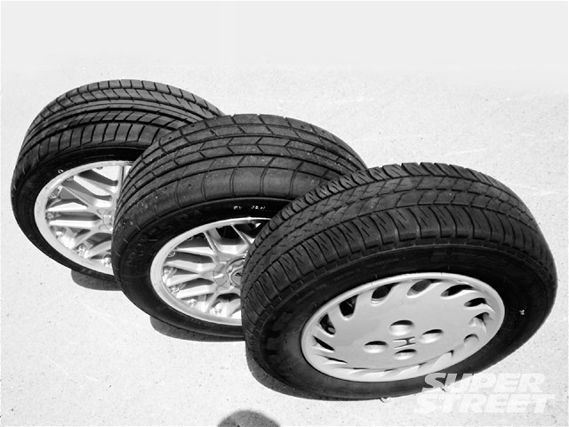 |
Improving 1989 Honda Civic Handling - Civic Class
|
Improving 1989 Honda Civic Handling - Civic Class
Both of the Toyo Proxes models used in this test worked extremely well. The RA-1 is a DOT street-legal racing compound tire. This tire provides serious traction for competition purposes. By using a softer rubber compound, tire makers increase traction but at the cost of accelerated wear. The Toyo RA-1 offers excellent grip, but wear is still outstanding for this type of tire. The T1 Plus is a street compound high-performance tire that offers outstanding cornering performance, a tread pattern suitable for most weather conditions and great wear characteristics.
The skidpad left and right turn average on the T1 Plus was an incredible 0.964 Gs. For a daily-driver offering outstanding wear and wet road performance, this cornering force is awesome. On the RA-1 tires with the more aggressive tread and sidewall design and stickier rubber, the left/right average on the skidpad was a whopping 1.007 Gs. To get this number, many racers would sell important body parts.
Before you bound off the couch and dash out the door for your nearest Toyo dealer, there's more to this story. While tires make the traction, the suspension is what dictates how the tires work. To get those kinds of skidpad numbers, the tire contact patches must be equally loaded and flat on the road surface during cornering, braking, and acceleration. If the tires are not correctly loaded, the balance of the car is off, speed is lost, and drivability takes a big dump. And if the tire contact patch is tilted, you might as well save a few bucks and buy a set of 155/70R13 tires, because that's about how much traction you'll have on tap if the suspension does not keep the meat of the tire on the ground.
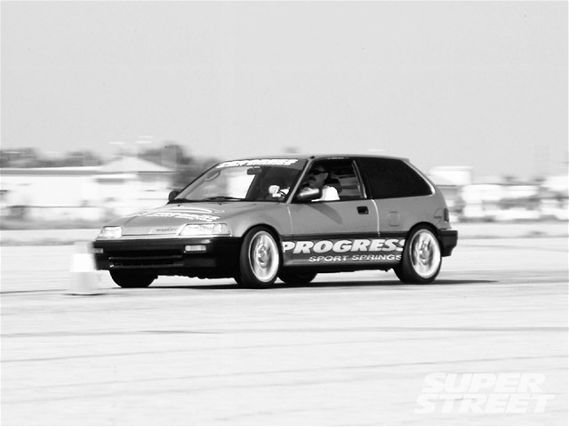 |
Improving 1989 Honda Civic Handling - Civic Class
|
Improving 1989 Honda Civic Handling - Civic Class
The suspension system must control body roll to make the tilt of the tires correct for cornering, keep the tires on the road surface over bumps and ruts, maintain handling balance, and provide nearly instant response to driver steering inputs. It's also important to maintain some ride quality so that your teeth don't rattle loose while you're going to the movies. To get to this pinnacle of performance handling requires sound engineering, strong R&D, and track-testing. Progress has a handle on this based on the performance of the Honda Civic.
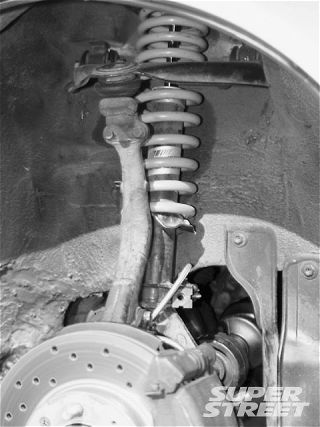 |
Improving 1989 Honda Civic Handling - Civic Class
|
Improving 1989 Honda Civic Handling - Civic Class
The heart of a suspension system are the springs. Springs perform five critical jobs. First they keep the chassis and suspension from bottoming out over bumps. Second, they control the tires over bumps. Third, they control body roll during cornering, chassis squat during acceleration, and chassis dive under braking. Fourth, the springs determine how the load on the tires shifts during braking, cornering, and acceleration. This is a major factor in establishing the neutral handling balance of the car. And finally, the springs are the major factor in establishing the ride height (ground clearance) of the chassis. If springs are too soft, the chassis or suspension could bottom-out over bumps. The body can roll, dive, or squat too much causing the tire contact patch to be tilted relative to the road surface, which can hurt traction. If the springs are too stiff, ride quality is unacceptable for street driving and the tire contact patch can lose touch with the road surface over bumps and ruts. The series of compromises needed to create the ideal setup for a given car and performance application requires experience, sound engineering, and testing.
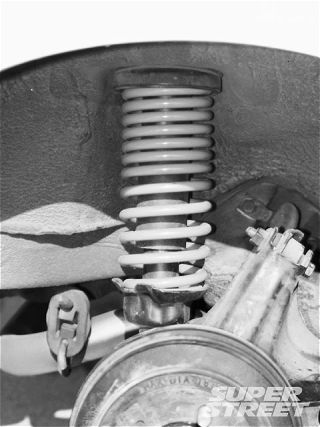 |
Improving 1989 Honda Civic Handling - Civic Class
|
Improving 1989 Honda Civic Handling - Civic Class
Sport springs should lower the car, which not only improves the look, but also lowers the center of gravity and improves handling performance. But if the springs are not stiff enough at the lower ground clearance, the chassis or suspension will bottom, causing damage. If the springs are too stiff, the ride is horrible and tire contact patch control over bumps deteriorates. The Progress Sport Springs provide a compromise between ground clearance, ride quality, tire control, and handling balance.
The next component in the food chain of handling performance is the antiroll bar. Antiroll bars control body roll, which helps keeps the tire contact patch flat on the road surface. They also contribute to the control of loading on the tires, which is a factor in handling balance. The front and rear antiroll bars are an excellent way to tune handling balance without affecting ride quality. The Progress AntiRoll System for the '88-'91 Honda Civic uses a 25mm front bar and a 22mm rear bar.
Next come the shock absorbers. Shocks control the bouncing of the suspension springs. Without them, the chassis would continue to bounce over bumps. Good-quality stock shocks can accomplish this reasonably well, but will fall far short when it comes to performance handling. Shocks play a major role in responsiveness and in transitional handling. Progress has developed its own performance shock for Hondas called the ProSport. The Progress ProSport is a twin-tube low-pressure gas shock specially tuned to work with the Progress Sport Springs and Progress Antiroll System. The compression and rebound damping rates of these shocks are considerably stiffer than stock. While the ride is firmer than stock, it is very acceptable considering the level of performance. These shocks allow precise and nearly instant response to driver steering inputs. The ratio of compression to rebound damping is ideal for quick turn-in and exceptional for transitional handling response, which we were able to experience first-hand on the straight line slalom. If the shocks are too soft, response is sluggish. If they are too stiff, the car is twitchy and rough.
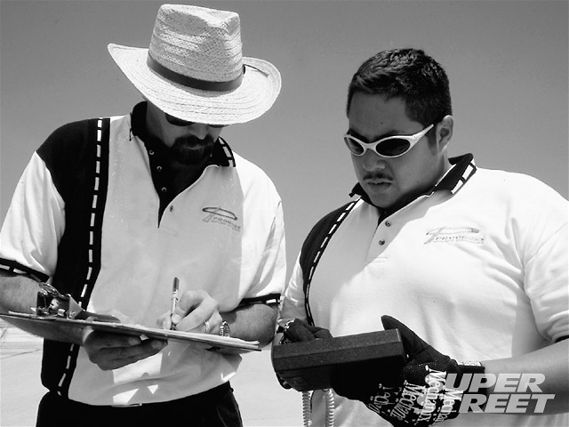 |
Improving 1989 Honda Civic Handling - Civic Class
|
Improving 1989 Honda Civic Handling - Civic Class
The next components in the integrated suspension system are the suspension bushings. All of the precise control needed for the tires to do their job goes right out the window when soft bushings are used in the suspension control arms and linkages. The bushings must be stiff to allow perfect control, but must not be too noisy for street driving. Metal bushings are very noisy, which is fine for racing applications, but undesirable for the road. Progress selected the Energy Suspension Master Kit for the '88-'91 Honda Civic. The urethane bushings used by Energy provide the precise control needed in a 1.0 G car but keep the noise level low for a more enjoyable cruise to the local hot spot. The Energy Suspension bushings work extremely well. When bushings are soft and compliant, you can feel the slop in the steering wheel. Not so with the Energy bushings.
 |
Improving 1989 Honda Civic Handling - Civic Class
|
Improving 1989 Honda Civic Handling - Civic Class
Rounding out the handling part of the package are the wheels. A performance wheel must be light and very rigid to extract the most out of the tires and suspension. Progress selected the Axis Racing Spec wheels for both tire selections. The 15x7-inch wheels were used with the Toyo Proxes RA-1 tires, while the T1 Plus tires went on the 17x7-inch rims. All wheels were 38mm offset for the Civic application.
An integral part of a handling package should include performance brake components. A car that is capable of 1.0 G cornering can decelerate at the same rate, and the brake system needs to be able to handle the increased forces and heat. Progress added Power Stop cross-drilled rotors to the Civic to improve speed reduction over many stops. Axxis brake pads were used to provide the needed friction to take advantage of the tire traction available. To assure consistent stops at the limit, Castrol DOT 4 brake fluid was used. And to improve pedal feel and reduce pedal travel, Goodridge steel braided brake lines were added to the system. Over the course of the test, with repeated stops from 70 to 80 mph, the brakes performed flawlessly. The pedal felt precise with solid feedback. There was no sign of brake fade, and stopping power was exceptional.
When this car was first tested during product development, I was able to flat-foot it around the 200-ft-diameter skidpad at the test track. While this was very much due to the exceptional handling of the Progress Civic, it was also due to a lack of ponies. More horsepower would actually make the car slightly faster on the skidpad. Four items were added to allow the little Civic engine to make more grunt. Moroso Blue Max ignition wires assured that adequate juice arrived at the spark plugs. An AEM air intake improved airflow to the intake system and a Hooker Headers after-cat system with the Tuned Flow Meg Muffler allowed that extra intake flow to exhaust smoothly. The Hooker Tuned Flow Meg Muffler features an adjustable flow that can be changed up to 40 percent (which means sound is also altered by as much as 40 percent) with the 2-inch system. And an AEM cam timing gear was installed to allow optimum camshaft timing. These changes added enough extra power to make the car more responsive to throttle inputs, and the car could no longer be driven around the skidpad flat out.
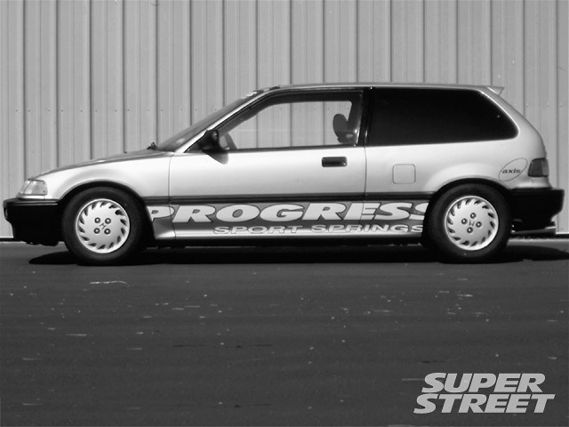 |
Improving 1989 Honda Civic Handling - Civic Class
|
Improving 1989 Honda Civic Handling - Civic Class
Cone-Killer Romans Strikes Again The Progress Group invited me up to Camarillo Airport to partake in the test of Jeffie the Civic. I don't know why. My reputation for running over orange cones is known throughout the galaxy.
Don Alexander, the author of this story, told me that a skidpad is like a dyno for tires and suspension. If that's true, then getting 1.0G out of a Civic seems as crazy to me as getting 350hp out of its engine.
Driving on a skidpad is more difficult than it looks. In theory, all you do is drive around in a circle a bunch of times until you get so dizzy that you have to stop. But keeping the car at its absolute limit of traction requires constant steering and throttle input. The trick is to make the inputs as small as possible. On cars as well-balanced as this Civic, lifting off the throttle slightly results in perfect trailing-throttle oversteer. Both sets of Toyo tires were great to drive on, with the RA-1s providing a bit more grip and predictability.
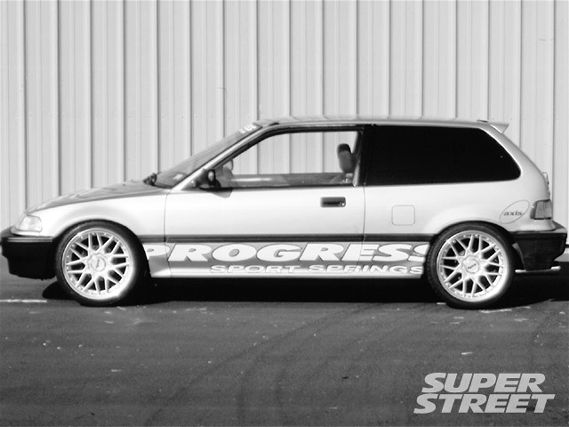 |
Improving 1989 Honda Civic Handling - Civic Class
|
Improving 1989 Honda Civic Handling - Civic Class
The slalom test is interesting, as well. A set of cones is set up at 100-foot intervals. Again, you use small inputs of steering and throttle to dance the car through the cones. The better the handling, the faster the car can go through the cones. Horsepower also has a small effect on how well a car does in a slalom test. The Civic was easy to drive, posting slalom speeds of 65-68 mph. -Brent Romans
Progress Honda Civic Test Results Test 1 Michelin 175/70R13 Tires Left Turn Elapsed Time: 11.95 seconds Right Turn Elapsed Time: 12.12 seconds Two-Way Average G Force: 0.862 Gs Driver Comments: The Civic was well balanced and surprisingly quick on these tires. There was virtually no body roll due the stiffer suspension and low grip of the small tires.
Test 2 Toyo Proxes T1 Plus 205/40ZR17 Tires Left Turn Elapsed Time: 11.24 seconds Right Turn Elapsed Time: 11.57 seconds Two-Way Average G Force: 0.956 Gs Driver Comments: Excellent grip. Very predictable and easy to drive at the limit. Changes: Increase tire pressure in left front tire.
Test 3 Toyo Proxes T1 Plus 205/40ZR17 Tires Left Turn Elapsed Time: 11.23 seconds Right Turn Elapsed Time: 11.54 seconds Two-Way Average G Force: 0.964 Gs Driver Comments: The tire pressure change helped a little. These tires are a big surprise.
Test 4 Toyo Proxes RA-1 205/50ZR15 Tires Left Turn Elapsed Time: 11.09 seconds Right Turn Elapsed Time: 1.28 seconds Two-Way Average G Force: 0.996 Gs Driver Comments: The grip is phenomenal. Very predictable and easy to drive at the limit. The tires hook up really well, and the suspension is working just the way it should. Lift off the throttle and the small trailing throttle oversteer helps steer the car into the circle. Very nice. Changes: Increase tire pressure in rear; decrease tire pressure at right front.
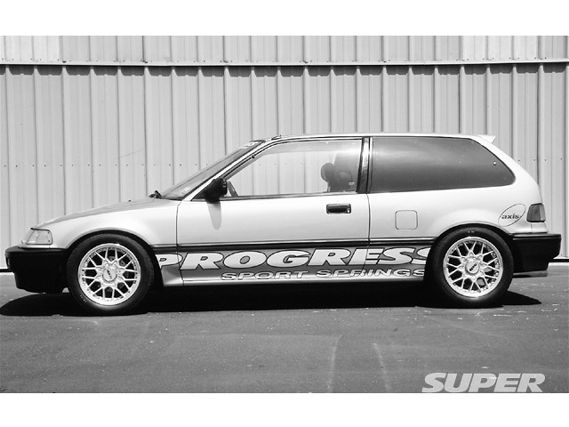 |
Improving 1989 Honda Civic Handling - Civic Class
|
Improving 1989 Honda Civic Handling - Civic Class
Test 5 Toyo Proxes RA-1 205/50ZR15 Tires Left Turn Elapsed Time: 11.05 seconds Right Turn Elapsed Time: 11.23 seconds Two-Way Average G Force: 1.007 Gs Driver Comments: There is a little left in the tire with more tuning, but the overall pack really works superbly right now. It's hard to imagine a better balance at the level of grip the Toyo RA-1s provide.

